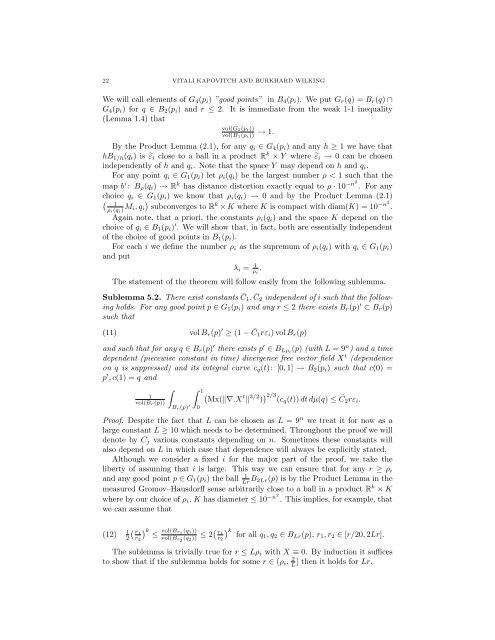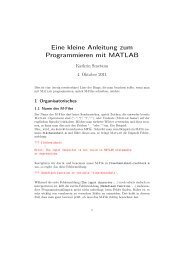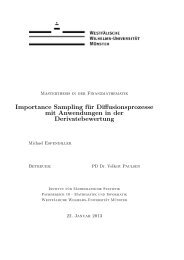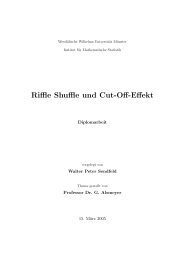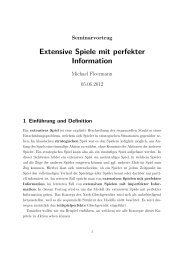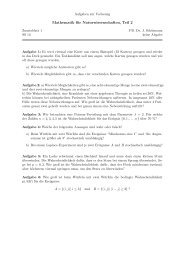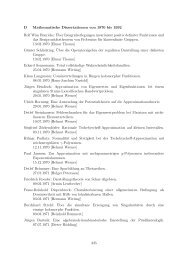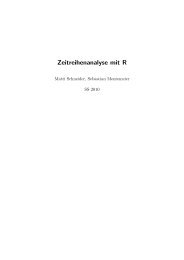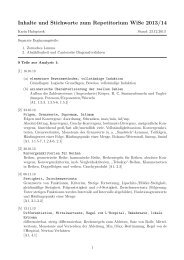Margulis Lemma
Margulis Lemma
Margulis Lemma
Create successful ePaper yourself
Turn your PDF publications into a flip-book with our unique Google optimized e-Paper software.
22 VITALI KAPOVITCH AND BURKHARD WILKING<br />
We will call elements of G 4 (p i ) ”good points” in B 4 (p i ). We put G r (q) = B r (q) ∩<br />
G 4 (p i ) for q ∈ B 2 (p i ) and r ≤ 2. It is immediate from the weak 1-1 inequality<br />
(<strong>Lemma</strong> 1.4) that<br />
vol(G 1(p i))<br />
vol(B 1(p i)) → 1.<br />
By the Product <strong>Lemma</strong> (2.1), for any q i ∈ G 4 (p i ) and any h ≥ 1 we have that<br />
hB 1/h (q i ) is ˜ε i close to a ball in a product R k × Y where ˜ε i → 0 can be chosen<br />
independently of h and q i . Note that the space Y may depend on h and q i .<br />
For any point q i ∈ G 1 (p i ) let ρ i (q i ) be the largest number ρ < 1 such that the<br />
map b i : B ρ (q i ) → R k has distance distortion exactly equal to ρ · 10 −n2 . For any<br />
choice q i ∈ G 1 (p i ) we know that ρ i (q i ) → 0 and by the Product <strong>Lemma</strong> (2.1)<br />
(<br />
1<br />
ρ M )<br />
i(q i) i, q i subconverges to R k × K where K is compact with diam(K) = 10 −n2 .<br />
Again note, that a priori, the constants ρ i (q i ) and the space K depend on the<br />
choice of q i ∈ B 1 (p i ) ′ . We will show that, in fact, both are essentially independent<br />
of the choice of good points in B 1 (p i ).<br />
For each i we define the number ρ i as the supremum of ρ i (q i ) with q i ∈ G 1 (p i )<br />
and put<br />
λ i = 1 ρ i<br />
.<br />
The statement of the theorem will follow easily from the following sublemma.<br />
Sublemma 5.2. There exist constants ¯C 1 , ¯C 2 independent of i such that the following<br />
holds. For any good point p ∈ G 1 (p i ) and any r ≤ 2 there exists B r (p) ′ ⊂ B r (p)<br />
such that<br />
(11) vol B r (p) ′ ≥ (1 − ¯C 1 rε i ) vol B r (p)<br />
and such that for any q ∈ B r (p) ′ there exists p ′ ∈ B Lρi (p) (with L = 9 n ) and a time<br />
dependent (piecewise constant in time) divergence free vector field X t (dependence<br />
on q is suppressed) and its integral curve c q (t): [0, 1] → B 2 (p i ) such that c(0) =<br />
p ′ , c(1) = q and<br />
1<br />
vol(B r(p))<br />
∫B r(p) ′ ∫ 1<br />
0<br />
(<br />
Mx(‖∇·X t ‖ 3/2 ) ) 2/3<br />
(cq (t)) dt dµ(q) ≤ ¯C 2 rε i .<br />
Proof. Despite the fact that L can be chosen as L = 9 n we treat it for now as a<br />
large constant L ≥ 10 which needs to be determined. Throughout the proof we will<br />
denote by C j various constants depending on n. Sometimes these constants will<br />
also depend on L in which case that dependence will always be explicitly stated.<br />
Although we consider a fixed i for the major part of the proof, we take the<br />
liberty of assuming that i is large. This way we can ensure that for any r ≥ ρ i<br />
1<br />
and any good point p ∈ G 1 (p i ) the ball<br />
Lr B 2Lr(p) is by the Product <strong>Lemma</strong> in the<br />
measured Gromov–Hausdorff sense arbitrarily close to a ball in a product R k × K<br />
where by our choice of ρ i , K has diameter ≤ 10 −n2 . This implies, for example, that<br />
we can assume that<br />
(<br />
1<br />
(12)<br />
r1<br />
) k vol(B<br />
2 r 2<br />
≤<br />
r1 (q 1))<br />
vol(B r2 (q ≤ 2( )<br />
r 1 k<br />
2)) r 2<br />
for all q1 , q 2 ∈ B Lr (p), r 1 , r 2 ∈ [r/20, 2Lr].<br />
The sublemma is trivially true for r ≤ Lρ i with X ≡ 0. By induction it suffices<br />
to show that if the sublemma holds for some r ∈ (ρ i , 2 L<br />
] then it holds for Lr.


